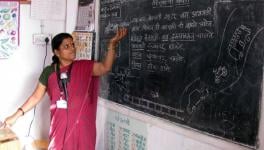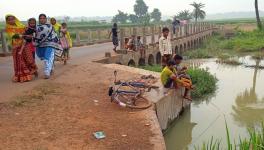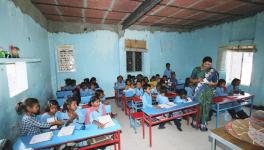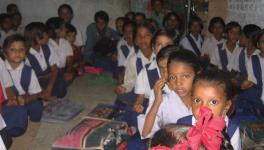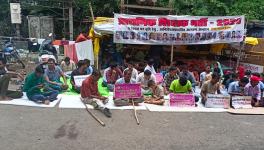Proportion of Girls Enrolled in Govt Institutions Higher Than Boys: ASER Report

The number of girls enrolled in government schools is higher than boys in the age group of 4-8 years, according to the 14th Annual Status of Education Report (ASER) released on January 14. The report portrays facts on the schooling status as well as on a range of important developmental indicators for young children in the age group 4-8.
According to the report, among 4-5 year old children, 56.8% of girls and 50.4% boys are enrolled in government schools or pre-schools while 43.2% girls and 49.6% boys are enrolled in private pre-schools or schools.
“The gap in enrolment between boys and girls is larger among 6-8 year olds, with 61.1% of all girls versus 52.1% of all boys in this age group going to a government institution,” said the report based on a survey that had been conducted in 26 districts across 24 states of the country covering 36,930 children in this specified age group from a total of 1,514 villages.
The report says that in the human life cycle, the early years, defined globally as age 0-8, are known to be the most important stage for cognitive, motor, social and emotional development. Many researches suggest that exposure to enabling environments and access to appropriate inputs during these years is fundamental to ensure that children have a firm foundation, both in school and in life.
Also read: Why India Needs an Absolutely Free Public Education System
In India, like in many low and middle-income countries, there is little evidence with respect to whether young children have access to pre-primary facilities and whether they are acquiring the foundational skills and abilities that are key to subsequent success in school and beyond. The report seeks to fill this gap.
The report found that more than 90% children in the 4-8 age group are enrolled in some type of educational institution. Though the proportion increases with age – from 91.3% of all 4-year-old to 99.5% of all 8-year-olds in sampled districts – there are variations in terms of where they have been enrolled.
For example, among the children in the age group 5-year-old, 70% children are in anganwadis or pre-primary classes, but 21.6% are already enrolled in Std I. At age 6, 32.8% children are in anganwadis or pre-primary classes, while 46.4% are in Std I, and 18.7% are in Std II or higher.
As far as gender of the children is concerned, there are variations in the enrolment pattern and the gap grows larger as children get older. Proportion of girls enrolled in government institutions is higher than that of boys, the report shows.
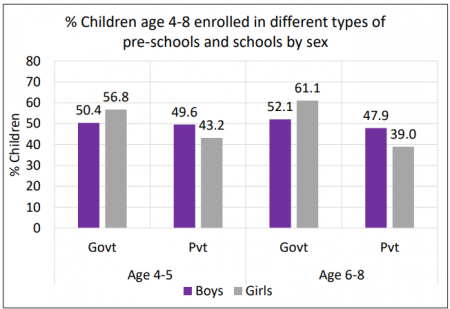
Despite the recommendation that children in the age group of 4-5 should be enrolled in pre-school, the percentage of enrolment of kids varies drastically across the country. National policy recommends that at this stage, children should be encouraged to develop a range of abilities and skills, including cognitive, social and emotional skills as well as the conceptual foundations needed for formal schooling.
The report states that in Thrissur district of Kerala, 89.9% of 5-year-olds are in a pre-primary grade and almost all the rest are in Std I. However, when it comes to East Khasi Hills, Meghalaya, just 65.8% are in pre-school, 9.8% are in Std I, and 16% are in Std II. While in Satna, Madhya Pradesh, 47.7% are in pre-school, 40.5% are in Std I, and 4.1% are in Std II.
“From age 4 to 5, children’s ability to do all tasks improves substantially, in line with what child development experts expect and other studies have found. Regardless of whether or where they are enrolled, young children’s ability to do cognitive, early language, early numeracy, and social and emotional learning tasks is higher among 5-year-olds than among 4-year-olds. For example, while 31% of 4-year-olds enrolled in anganwadis or government pre-primary classes were able to do a 4- piece puzzle, 45% of 5-year-olds attending these institutions could do so,” said the report.
Though at age 5 children should be able to do most of these tasks with ease, a large proportion is unable to do so especially the children from less advantaged homes. But, “almost half of all 4-year-olds and more than a quarter of all 5-year-olds are enrolled in anganwadis. These children have far lower levels of cognitive skill and foundational ability than their counterparts in private LKG/UKG classes.” These are the young ones who spend much of their time at home. It is also noted that the differences in outcomes may be driven mainly by children’s home characteristics.
“Among the pre-primary age group, children with mothers who had completed eight or fewer years of schooling are more likely to be attending anganwadis or government pre-primary classes; whereas their peers whose mothers studied beyond the elementary stage are more likely to be enrolled in private LKG/UKG classes,” added the report.
The Right to Education Act 2009 (RTE) mandates that children should enter first standard at age 6. The statistics of the study shows 41.7% of children in Std I are of the RTE-mandated age of 6 years, 36.4% are 7 or 8 years old, and 21.9% are 4 or 5 years old. Also, children in first standard in government schools are younger than those in the same grade in private schools.
“More than a quarter of Std I students in government schools are either 4 or 5 years old at 26.1%, while the corresponding proportion for private schools is ten percentage points lower at 15.7%. On the other hand, 30.4% students in Std I in government schools are 7-8 years old, while this proportion in private schools is far higher at 45.4%,” further added the report.
Also read: Fee Hike Means Further Exclusion of Common Students from Education
It is also important to note the role of anganwadis that cater to large proportions of children well before they can enter pre-primary grades. As a conclusive note, the report suggests that the already significant scale of this network can be leveraged to reach those children who remain out of reach. At the same time, the ability of these centres to implement appropriate school readiness activities for 3 and 4-year-olds needs to be strengthened. Data also shows that performance in cognitive, early language, early numeracy, and social and emotional development tasks is closely related to children's age, with older children doing better than younger ones. Permitting underage children into primary grades puts them at a learning disadvantage which is difficult to overcome.
Get the latest reports & analysis with people's perspective on Protests, movements & deep analytical videos, discussions of the current affairs in your Telegram app. Subscribe to NewsClick's Telegram channel & get Real-Time updates on stories, as they get published on our website.










